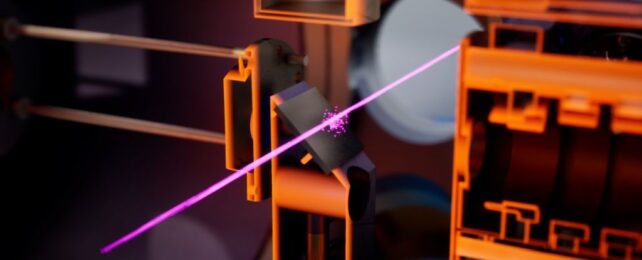Teams of physicists at CERN and the University of Tokyo have both taken a major step forward towards understanding a flighty, short-lived particle.
Using a laser designed to meet the experiment's specifications, the AEgIS collaboration succeeded in reducing the temperature of a cloud of positronium by more than half. This collection of exotic particles consists of just an electron and its antiparticle, the positron.
Meanwhile, a team at the High Energy Accelerator Research Organization in Japan led by physicist Kenji Shu of the University of Tokyo has reduced the temperature of a cloud of positronium to around a Kelvin (-272 °C), effectively reducing the overall speed and distribution of electron and positron velocities significantly.
Positronium is the lightest known particle system, and it's extremely unstable. Matter and antimatter annihilate each other, and handily, too, spitting out a flash of radiation. Positronium annihilates itself in 142 billionths of a second, disappearing in a burst of gamma rays.
In addition, when produced in the clouds required for experimental studies, positronium zips around at a huge range of velocities, making it really difficult to pin down.
One way to resolve this would be to cool down the positronium. This would slow its particles so more accurate measurements of its properties could be taken.
But, well, that's easier said than done. Gases can be slowed a number of ways, but many methods take time, removing the more energetic particles for example so the distribution of velocities tends towards the dawdlers.
Laser cooling is a method of temperature reduction based on particles absorbing and emitting photons. When a particle absorbs a photon, it gains energy; when it emits the photon, it loses energy.
If laser light is directed along the path of incoming particles, those particles will absorb the photon, and re-emit it in a random direction that changes its momentum and slows it down. But the wavelength of the laser light has to be tuned to the energy level of the particle.
Scientists first proposed the method of laser cooling for positronium decades ago, in 1988. It has taken until now to achieve it.
Using different laser cooling techniques, the two independent teams succeeded in reducing the velocity distribution of their samples and cooling them down. Using broadband laser cooling, which targets a wide velocity distribution, AEgIS managed to cut the temperature of their sample down from 380 Kelvin to 170 Kelvin (106 °C to -103 °C) – a reduction of more than half.
Meanwhile, Shu's team used chirp cooling – which relies on adjusting the laser to match the deceleration of the particles – to shrink the distribution of particle movements within their own sample.
There are many reasons to want to study antimatter. One of the big ones is to find out where it all went.
When the Universe formed, there should have been equal amounts of both matter and antimatter, and there very much is not an equal distribution now (which is great news for us, because otherwise the Universe would probably have been snuffed out). Knowing if antimatter always behaves the same way as matter would go a long way to providing a few clues on this mystery.
Physicists also want to create a Bose-Einstein condensate of positronium. That's when a cloud of particles is cooled to just above absolute zero, resulting in a high-density cloud of particles that acts as one super-particle. A positronium Bose-Einstein condensate, physicists believe, could be used to generate coherent gamma-ray light due to the self-annihilation of the positronium within.
This is a powerful tool that could be used to reveal the very finest structure of the atoms that make up the Universe.
"A Bose-Einstein condensate of antimatter would be an incredible tool for both fundamental and applied research," explains AEgIS spokesperson Ruggero Caravita of CERN, "especially if it allowed the production of coherent gamma-ray light with which researchers could peer into the atomic nucleus."
The work of the AEgIS collaboration has been published in Physical Review Letters.
The work of Shu et al. is available as a preprint on arXiv.
